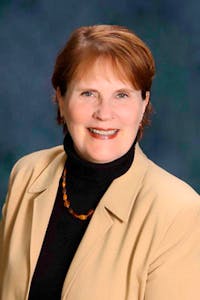Beyond Biometrics: The Impact of UR Medicine Employee Wellness
By Robin Flanagan
Tuesday, January 16, 2024
 Cheryl Ellenwood had always gotten good results from her biometric health screenings. So when her numbers rose
Cheryl Ellenwood had always gotten good results from her biometric health screenings. So when her numbers rose
to concerning levels despite what she considered to be a decent diet and exercise regimen, she turned to UR Medicine Employee Wellness.
The nurse-led program provides services to more than 63,000 employees in 83 organizations in Western New York.
“I thought I was going to get all the same information I already knew and that I’d just be told, ‘Keep doing what you’re doing — just do more of it,’” said Ellenwood, an LPN who works for the Department of Anesthesiology
at Strong Memorial Hospital. “But it wasn’t like that at all. There was so much I didn’t know.”
UR Medicine Employee Wellness’s comprehensive high touch and high-tech coaching and engagement program has consistently proven effective since 2012 in reducing cardiovascular risk, lowering blood glucose and blood pressure, and diminishing depression symptoms.
That’s good news for both employees and employers, given that 90 percent of health care spending is attributed to the treatment of chronic conditions, and 60 percent of adults have at least one, according to the Centers for Disease Control and Prevention.
 “We put a lot of stock in interacting with our clients in meaningful ways,” says Chief Wellness Officer Lisa Norsen, PhD, RN, ACNP. “Our programs take into account not only what individuals desire, but what their cultural needs are, the resources they have at their disposal, and their motivation level. We customize their experience so they can be successful.”
“We put a lot of stock in interacting with our clients in meaningful ways,” says Chief Wellness Officer Lisa Norsen, PhD, RN, ACNP. “Our programs take into account not only what individuals desire, but what their cultural needs are, the resources they have at their disposal, and their motivation level. We customize their experience so they can be successful.”
That customization is done through biometric screenings and face-to-face interactions. It’s a model wholly different from the usual one-size-fits-all programs administered through digital platforms.
“Just knowing that I had someone to be accountable to helped motivate me,” said Ellenwood, who was matched with Clinical Nutritionist Catherine Pluta. “I wanted to do a good job — not only for myself but for her too.”
Ellenwood had two sessions with Pluta before having to take time off for shoulder surgery. By the time she started up again six weeks later, the 5-foot-3 nurse realized the break came with some weight gain.

Over the next six months, with Pluta’s guidance, Ellenwood discovered she could make a lot of changes to a diet she once thought was fairly ideal. She swapped ketogenic meals heavy on meat and cheese for a more plant-based menu with lots of fruit and vegetables. She uses olive and avocado oils instead of grapeseed and sesame oils, and has severely cut consumption of commercial breads, cookies, cereals, and other foods with trans fats and hydrogenated oils. She limits ice cream to once every two weeks instead of indulging twice a week. And she has upped her daily water intake from 50 ounces to 85 ounces.
When buying packaged products, Ellenwood uses a simple mathematical rule she learned from Pluta. She divides carbohydrates by dietary fiber and if the number is five or lower, it gets a seal of approval.
“You’d be amazed how many ‘good for you’ products are over seven,” Ellenwood said, referring to misleading marketing labels.
Unlike typical for-profit wellness companies, notes Norsen, UR Medicine Employee Wellness sits in the School of Nursing and is part of the University of Rochester Medical Center, which makes it unique among wellness
organizations. As part of the University, the program has access to resources that keep the programs and practitioners responsive, current, and innovative.
One example Norsen offers is the integration of Self- Determination Theory into their clinical practice. Developed
by University of Rochester psychologists Richard Ryan and Edward Deci, the theory emphasizes the role of autonomy, competence, and relatedness in fostering intrinsic motivation and psychological well-being.
“Use of theory is important because it gives us a foundation and assures we have a roadmap for customization moving forward,” Norsen said.
Another unique aspect of the program is that all nurses are also certified lifestyle coaches, making for a “pretty
remarkable and powerful combination,” said Norsen.
Ellenwood has lost 18 pounds since working with the employee wellness program and has been able to maintain her weight for several months. “I am happier, healthier, and back to a weight that much more fits my frame,” she says.
“And I found out I love falafel. Who knew? This was a really great, really enlightening experience.”
UR Medicine Employee Wellness results go beyond financial figures.
For every $1 spent on UR Medicine Employee Wellness services, employers see a $6 return on investment — an overall savings of $1,224.20 per individual.
“Nothing in our industry has approached that level of ROI,” says Jason DeVoe, director of business operations for the University of Rochester School of Nursing, where the program is housed.
For groups at risk of cardiovascular disease, the ROI is even higher — with a rate of return shooting up to $36 for males and $20 for females, according to a 2022-23 analysis.
In 2019, the program conducted a five-year retrospective study to measure change in cardiovascular disease risk for over 9,000 employees who participated in the program’s services for more than one year. The findings were
unparalleled in the industry and published in a peer reviewed journal that same year.
Data showed that 48 percent of participants with moderate to high cardiovascular risk improved their risk level, and 33 percent improved a full risk category. Meanwhile, the program’s Net Promoter Score — a metric measuring customer experience — is 85 for biometric screenings and 75 for its wellness portal.
“Companies brag about scores around 40 or 45, so this is something we’re really proud of,” DeVoe says. “Having an immediate coaching interaction at the time of the biometric screening with a registered nurse is unbelievably impactful."
This story was published in the Winter 2024 issue of NURSING Magazine.
Categories: Patient Care, Community, Wellness

